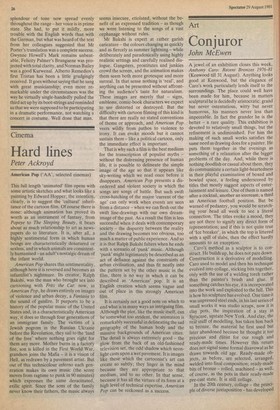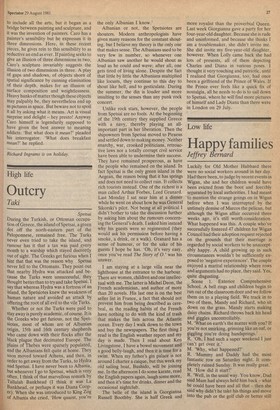Art
Conjuror
John McEwen
A jewel of an exhibition closes this week, Anthony Caro: Recent Bronzes 1976-81 (Kenwood till 31 August). Anything looks good at Kenwood, but the elegance of Caro's work particularly lends itself to the surroundings. The place could well have been made for him, because in matters sculptural he is decidedly aristocratic: grand but never ostentatious, witty but never humorous, his manners never less than impeccable. In fact the grander he is the better — a rare quality. This exhibition is devoted to relatively small things, but the refinement is undiminished. For him the making of such small works satisfies the same need as drawing does for a painter. He puts them together in the evenings as something of a relaxation after the bigger problems of the day. And, while there is nothing doodlish or casual about them, they do communicate a certain light-heartedness in their playful examination of boxed and bowled space, a feeling underscored by titles that mostly suggest aspects of entertainment and leisure. One of them is named after a cocktail, another an icecream, a third an American football position. But be warned of pedantry, you would be scratching your head all week to see a literal connection. The titles evoke a mood, they are not there to signify any direct form of representation; and if this is not quite true of 'Ice breaker', in which the top is littered with a spill of slabs, then the effect hardly amounts to an exception.
Caro's method as a sculptor is to construct. He builds up, he does not pare down. Construction is a derivative of modelling. Caro used to model and then his technique evolved into collage, sticking bits together, only with the use of a welding torch rather than the painter's brush and glue. If something catches his eye, it is incorporated into the work and exploited to the full. This is how his sculpture has evolved. One time it was unpressed steel ends, in his last series of small works it was studio scraps, now it is clay pots, the inspiration of a stay ill Syracuse, upstate New York. And clay, the real stuff of modelling, has taken him back to bronze, the material he first used but later abandoned because he thought it too precious and elitist for our rough and ready-made times. However this return does not signal some formal disavowal as he draws towards old age. Ready-made objects, as before, are selected, arranged, welded into final composition; ready-made bits of bronze — rolled, machined — as well, of course, as the pots in their ready-made pre-cast state. It is still collage. In the 20th century, collage — the principle of diverse juxtaposition — has developed to include all the arts, but it began as a bridge between painting and sculpture, and it was the invention of painters. Caro has a painter's sensibility but he expresses it in three dimensions. Here, in these recent pieces, he gives rein to this sensibility to as seductive an end as ever. If painting seeks to give an illusion of three dimensions in two, Caro's sculpture invariably suggests the illusion of two dimensions in three. A play of gaps and shadows, of objects shorn of spatial significance by cunning elimination of their depth, makes for an illusion of surface composition and weightlessness. Heavy hunks of matter though these objects may palpably be, they nevertheless end up as pictures in space. But beware not to spoil it all by asking what it means. Art is visual surprise and delight — hey presto! Anyway Caro himself is legendarily supposed to have given the best answer to meaning addicts: 'But what does it mean?' pleaded his interrogator. 'What does breakfast mean?' he replied.
Richard Ingrams is on holiday.



































 Previous page
Previous page